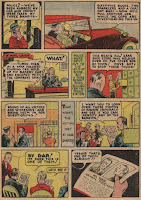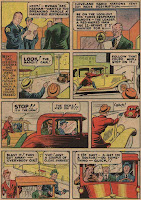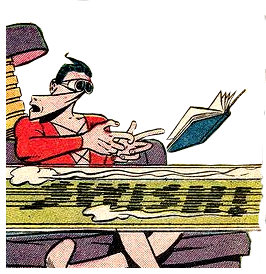 Story presented in this entry:
Story presented in this entry:
Military Comics #1 (August 1941) - "Death Patrol" Story and Art by Jack ColeThe first appearances of BLACKHAWK and the DEATH PATROL were in
Military Comics#1. It is sometimes said that Death Patrol was a parody of Blackhawk, as Cole's MIDNIGHT (Smash Comics) was a parody of THE SPIRIT, and as PLASTIC MAN was a parody of all superheroes. This is actually not the case.
At the 1999 San Diego Comic-Con,
Will Eisner was asked which came first, BLACKHAWK or DEATH PATROL. He replied, "If my memory serves me, Death Patrol was first. It was not as well-done. [Jack] Cole couldn't draw realistic figures the way Chuck Cuidera could and it was half-humor and half-satire. Blackhawk began as a serious adventure."
A subsequent conversation between Eisner and the panel attendees stated that publisher "Busy" Arnold got a look at Cole's Death Patrol and decided it was a good enough idea to render straight. So, in a way, Jack Cole set out to satirize miltary stories, but it was not at Blackhawk that he took aim.
Blackhawk won the cover and the lead-off position in Mikitary #1, and kept both through the comic's run. At issue 44, the title was changed to "
Modern Comics," because the war had ended.
One of the more striking themes in Cole's work is a pre-occupation with death and morbidity. The grim premise of his new series was that one of the members of the team would die each story. Cole stayed with the series for 3 episodes, through
Military #3.
Perhaps this is because in August 1941, both Death Patrol and Plastic Man made their debuts, and Cole may have decided to focus more on Plas, which seemed more likely to win him the cover and lead spot in
Police Comics.
Like Plastic Man, Jack Cole's Death Patrol is a breathless wonder of genuine boyish exuberance, Fleischer-studio subterranean sub-subconscious symbolism, and humor worthy of
Harvey Kurtzman. In fact, Kurtzman's
Mad parody of Blackhawk has always reminded me of Jack Cole's Death Patrol stories.
Cole returned to the series in March, 1944 with
Military #27. Now the stories were four pages in length, instead of six. In all, Cole did 8 Death Patrol stories, in
Military #1, 2, 3, 27, 28, 29, 30, 31.
Here is the first story. It's quite brilliant... full of camraderie, zany humor, and appeallingly eccentric characters, and Cole's trademark mastery of comic book design. Note how he uses the bottom half of page 1 and the top half of page 2 to show twin stories happening simultaneously.
Jack Cole has a field day with the black-and-white stripes of the escaped prisoner's uniforms, creating some very pleasing op-art effects as they group together and run around on the pages. Amusingly, the new uniforms they demand and are given at the end of this first story are revealed in the second story to be just like the striped prisoner suits, only they are tailored, with colllars. It's my guess Cole knew a good thing when he saw it and was reluctant to let go of such a great visual device.




 Crime stories were already a big part of American movies and radio by 1939. The famous gangster film, Scarface, came out in 1932, and a chain gang of gangster films followed in its bloody footsteps. Lucky Strike cigarettes sponsored a popular nationwide radio program in ther 1930's dramatizing true life FBI cases. Cole was perhaps a bit ahead of his time by bringing the winning combination of moralism and graphic violence to comic books. Generally, the popular wave of American crime comics is considered to have begun in 1942, with the start of Charles Biro's Crime Does Not Pay series. (By the way, Biro drew the cover of Blue Ribbon Comics #3, a superhero scene, from which this story is taken).
Crime stories were already a big part of American movies and radio by 1939. The famous gangster film, Scarface, came out in 1932, and a chain gang of gangster films followed in its bloody footsteps. Lucky Strike cigarettes sponsored a popular nationwide radio program in ther 1930's dramatizing true life FBI cases. Cole was perhaps a bit ahead of his time by bringing the winning combination of moralism and graphic violence to comic books. Generally, the popular wave of American crime comics is considered to have begun in 1942, with the start of Charles Biro's Crime Does Not Pay series. (By the way, Biro drew the cover of Blue Ribbon Comics #3, a superhero scene, from which this story is taken). 















 Jack Cole fan and expert, Art Spiegelman drew a marvellous cover for the April 17, 1999 issue of The New Yorker (which included his landmark essay on Jack Cole, later expanded into the totally awesome book, Jack Cole and Plastic Man: Forms Stretched to Their Limits) which gets at the same point.
Jack Cole fan and expert, Art Spiegelman drew a marvellous cover for the April 17, 1999 issue of The New Yorker (which included his landmark essay on Jack Cole, later expanded into the totally awesome book, Jack Cole and Plastic Man: Forms Stretched to Their Limits) which gets at the same point.



























